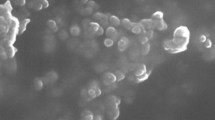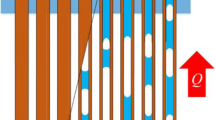Abstract
This paper deals with the performance characterization of heat pipes using an aqueous solution of long chain alcohols like n-Butanol, n-Pentanol, n-Hexanol and n-Heptanol as working mediums. These solutions are called as self-rewetting fluids, since these fluid mixtures possess a non-linear dependence of the surface tension with temperature. A cylindrical heat pipe made up of copper with two layers of wrapped screen is used as a wick material and partially filled with the self-rewetting fluid water mixture and tested for its heat transport capability like thermal efficiency and thermal resistance at different inclinations and input power levels. A number of tests have been performed with heat pipes, filled with various aqueous solutions of alcohols with a concentration of 2 ml/l in de-ionized water (DI water) on volume basis. The results obtained for heat pipes using self rewetting fluids show improved performances, when compared to DI water heat pipes.













Similar content being viewed by others
References
Faghri A (1995) Heat pipe science and technology. Taylor & Francis, Washington
Chi SW (1976) Heat pipe theory and practice. McGraw-Hill, Washington
Dunn PD, Reay DA (1994) Heat pipes, 4th edn. Pergamon, New York
Wadowski T, Akbarzadeh A, Johnson P (1991) Characteristics of a gravity assisted heat pipe based heat exchanger. Heat Recovery Syst CHP 11(1):69–77
Savino R, Monti R (2005) Heat pipes for space applications. Space Technol 25:59–61
Tanaka K, Abe Y, Nakagawa M, Piccolo C, Savino R (2009) Low-gravity experiments of light weight flexible heat pipe panels with self-rewetting fluids, interdisciplinary transport phenomena. Ann NY Acad Sci 1161:554–561
Savino R, Paterna D (2006) Marangoni effect and heat pipes dry out. Phys Fluids 18:118103
DiFrancescantonio N, Savino R, Abe Y (2008) New alcohol solutions for heat pipes: marangoni effects and heat transfer enhancement. Int J Heat Mass Transf 51:6199–6207
Savino R, Cecere A, DiPaola R (2009) Surface tension-driven flow in wickless heat pipes with self-rewetting fluids. Int J Heat Fluid Flow 30:380–388
Riffat SB, Zhao X, Doherrty PS (2005) Developing of a theoretical model to investigate thermal performance of a thin membrane heat pipe solar collector. J Appl Therm Eng 25:899–915
Chun W, Kang Y, Kwak H, Lee Y (1999) An experimental study of the utilization of heat pipes for solar water heaters. Appl Therm Eng 19:807–817
Savino R, Abe Y, Fortezza R (2008) Comparative study of heat pipes with different working fluids under normal gravity and microgravity conditions. Acta Astronaut 63:24–34
Savino R, DiFrance scantonio N, Fortezza R, Abe Y (2007) Heat pipes with binary mixtures and inverse marangoni effects for microgravity applications. Acta Astronaut 61:16–26
Zhang N (2001) Innovative heat pipe systems using a new working fluid. Int Commun Heat Mass Transf 28:1025–1033
Vochten R, Petre G (1973) Study of the heat of reversible adsorption at the air-solution interface, II. Experimental determination of the heat of reversible adsorption of some alcohols. J Child Interf Sci 42:320–327
Oron A, Rosenau P (1994) On a nonlinear thermocapillary effect in thin liquid layers. J Fluid Mech 273:361–374
Naphon P, Thongkum D, Assadamongkol P (2009) Heat pipe efficiency enhancement with refrigerant–nanoparticles mixtures. Energy Convers Manag 50:772–776
Acknowledgments
The authors thank the authorities of Annamalai University for providing the necessary facilities in order to accomplish this piece of work.
Author information
Authors and Affiliations
Corresponding author
Rights and permissions
About this article
Cite this article
Senthilkumar, R., Vaidyanathan, S. & Sivaraman, B. Comparative study on heat pipe performance using aqueous solutions of alcohols. Heat Mass Transfer 48, 2033–2040 (2012). https://doi.org/10.1007/s00231-012-1046-2
Received:
Accepted:
Published:
Issue Date:
DOI: https://doi.org/10.1007/s00231-012-1046-2




